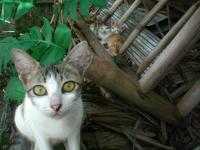Source: www.pet-grub.com
If you wish to quickly print this entire book with the greatest of ease, please read the following page:
Diabetes and Our Pets
Sponsored Links
Diabetes is a problem that many pets unfortunately suffer from.
The common medical approach is to give insulin to pets. This approach is designed to help pets live with diabetes rather than reverse the actual problem. With the use of insulin also comes the potential for some unwanted side effects. Unfortunately though, if a pet is diabetic then insulin may be a necessary evil.
It would be nice if we had time to reverse diabetes but sometimes we don't and so insulin is needed. Ultimately, the best thing to do is to work to help prevent diabetes before it even happens.
This page is thus designed to help bring some awareness about diabetes so hopefully more pets will avoid getting diabetes. At the same time, pets that already have diabetes can potentially benefit from this information too. It is said that the cure and the prevention are one and the same. Over the years, many people who contact me regarding their pets that have diabetes have told me that after eating a homemade diet that their pets require less insulin. This is a good thing.
I'm no expert on diabetes and this page isn't meant to provide revolutionary information about diabetes nor is it meant to cure pets of diabetes. Instead, I simply want to provide some thoughts about diabetes as it is an increasing problem with pets.
Usually, once a pet goes on insulin then after about 1 month or so, the body becomes dependent on the insulin and then the insulin must always be given. It's possible, in some cases, that perhaps the pet could come off insulin but something like this should only be done with the assistance of a veterinarian, preferably a holistic vet.
Depending on the severity of the diabetes, one might have no choice but to use insulin to help stabilize the pet's body. But in other situations, perhaps insulin is not needed.
Here's the thing about diabetes — in most situations diabetes is diet related. Thus in most situations, it can also be assisted through diet.
When the body is fed processed food, the food is broken down into sugars faster. The sugars are then released into the bloodstream faster. Now the blood needs sugar but it only needs so much. If the blood has too much sugar, then it can actually cause death. Therefore, the body creates insulin. The job of insulin is to take the excess sugar out of the bloodstream and store it as fat. Essentially, fat is stored sugar or energy.
In a diabetic pet, the body cannot produce enough insulin to remove the excess blood sugar. At this point, one might start to notice the early signs of diabetes such as excessive drinking. The body begins to drink a lot of water because the excess water is used to literally flush the sugar out of the blood and then out with the urine. This is why the urine of diabetics if often sweet. In India, especially in the past, the method to determine if a person is diabetic was to actually taste the urine to see if it is sweet.
Anyway, this is how diabetes essentially begins in most situations. Too much blood sugar and the inability to remove the excess blood sugar from the bloodstream.
Whole foods — this is where whole foods become so important.
The body was not designed to eat processed foods, but rather whole foods.
When the body eats whole foods, the food must be broken down through digestion. The digestive process takes time. As a result, sugar is slowly but surely released into the bloodstream. The sugar can be released over a period of a few hours while digestion takes place.
When the body eats whole foods, at no time will the blood sugar be too high or too low. The body does not rely upon insulin, created by the pancreas, to remove excess sugar from the bloodstream because there is no excess sugar now, but rather a healthy amount of sugar in the bloodstream. This allows the body to save the insulin for when it is really needed.
Now when you eat processed foods, you essentially remove part of the digestive process. As a result, the sugar is released faster. Brown rice is a whole grain while white rice is a processed grain. Essentially, white rice is missing the germ and bran. As a result, all that remains is the starch. So when you eat white rice, not only are you missing the all important germ and bran, but now you are also missing the all important fiber. Furthermore, all that you are eating now is the starch which is essentially sugar. So when you eat white rice your blood sugar will increase really fast and at the same time, you are eating a processed food which is missing so much of its important nutrition. When you eat brown rice, you are eating a whole food — a food which takes longer to digest allowing sugar to be supplied to the bloodstream slowly, but surely.
Commercial pet food can be compared to white rice while a homemade, natural diet can be compared to the brown rice.
In order to help pets with diabetes, or to help prevent diabetes in pets, it's vitally important to feed whole foods. It is the whole foods that help lower the blood sugar. More importantly, whole foods also help to supply a consistent supply of blood sugar so the body is neither diabetic (high blood sugar) or hypoglycemic (low blood sugar).
Many pets who have been borderline diabetic have seem incredible improvements after the introduction of wholesome foods — and pets that are already diabetic often need their insulin reduced.
To this date, I have yet to meet or talk to anyone whose pet is diabetic while eating a homemade diet. Of course, even while eating a homemade diet it is still possible for a pet to be diabetic due to poor genetics and other health complications. But generally speaking since diabetes is diet related, pets eating wholesome foods do not become diabetic.
Wholesome foods — it just common sense.
The body was not designed to drink soft drinks that are high in sugar — or foods that have been processed and are no longer whole.
Whole foods do the body good.
So in order to help diabetes, the first thing to always consider is diet.
In addition to diet, what else can be done?
Well, I decided to write this page on diabetes because I thought it was important to let people know that there is an Ayurvedic herb known as gymnema. This particular herb can found at your local health food store.
Now gymnema is well known to many, but not well known to others. So if you have a diabetic pet and haven't heard of gymnema then it is time you do some research.
One report I heard said that humans with Type I diabetes actually required less insulin after using gymnema. I unfortunately don't have the full details of this report as I only heard about it through a friend. Nonetheless, this is very interesting.
Supposedly gymnema has the ability to help lower blood sugar. For many, it has made a wonderful impact and it's could potentially help your pet if diabetic.
Other things to consider include minerals which are very important to help lower blood sugar. Herbs like alfalfa, aloe vera along with many other herbs help to stabilize the blood sugar levels. Please note that aloe vera should not be fed to cats unless it sodium benzoate or benzoic acid free. Sodium benzoate and benzoic acid are the same thing, just different names — and it is a natural preservative and safe for dogs, but it is toxic to cats. So don't give aloe vera to your cat unless it is free of this particular ingredient.
Anyway, minerals are important — and wouldn't you know it, but wholesome foods also have minerals in them. But would also suggest a trace mineral supplement. You will find an excellent trace mineral supplement in my pet store.
I also do not suggest anyone with a pet that is either diabetic or borderline diabetic to feed their pets grains. Unfortunately, commercial pet foods usually have grains in them — not because they are beneficial, but because they are a cheap ingredient. One reason why so many pets have diabetes today is due to the fact that commercial pet foods have used grains for so long and worst of all, processed grains similar to white rice. Our pets don't need grains. Feeding our pets a raw meat diet provides them with the protein they need without the excess amount of carbohydrates. Some people will say that our pets need no carbohydrates at all and that vegetables should not even be fed. Although, I still find a small amount of vegetables to be beneficial for most pets but I would only feed those vegetables that are low in sugar like cabbage.
In addition to the above, there are now homeopathic remedies for diabetes. These homeopathic remedies can help to stabilize the blood sugar levels.
Hopefully this information has helped you understand what causes diabetes in an elementary way — and how diet can help.
Signs or symptoms of diabetes in pets and even humans can include the following, usually in combination:
- Frequent urination
- Excessive thirst
- Extreme hunger
- Unusual weight loss
- Vomiting
- Increased fatigue
- Irritability
- Blurry vision
Are We Poisoning Our Pets?
Unfortunately, there are things in and around the home that can poison our pets. Do yourself and your pet a favour — read this page.
 Meet Jumbo, the participant in
Meet Jumbo, the participant in 